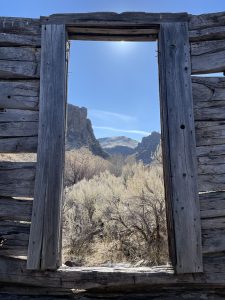The BLM’s proposed Public Lands Rule: What is it? Is it good for Idaho – and the West?
Twenty years ago, on a typical outing to a trailhead on your Bureau of Land Management (BLM) lands, you were likely to see raptors soaring overhead, some livestock grazing out in the expanse of sagebrush, perhaps some sage-grouse, and a few other recreationists at the trailhead – whom you likely knew. Take the same trip today and you will likely see new transmission lines, new roads, a gravel quarry, fire scars, firebreaks, thousands of acres of invasive annual grasses, and an overflowing parking lot at the trailhead filled with hikers, bikers and motorized enthusiasts. This scenario is playing out across much of the 12 million acres the BLM manages in Idaho (more than 20% of the State). The leadership at BLM noticed these changes too, and is proposing a new Public Lands Rule to help solve these issues and achieve the BLM’s mission. The BLM has actually been here before. Before 1976, BLM lands had been managed primarily for the benefit of extractive industries and the agency was not allowed to fully recognize the role that these lands play for wildlife, clean water, and recreation. In 1976, the Congress passed the Federal Land Management Policy Act (FLPMA), which established the BLM’s mandate for “multiple-use and sustained yield for present and future generations” and included conservation as a legitimate use for the first time.  In the newly proposed Public Lands Rule, the BLM makes the case that the conservation (aka the “sustained yield” component) is just as important as the “multiple use” side of its mission. The idea is that healthy and intact rangelands and watersheds are better able to support wildlife, be more resilient to climate change, and withstand extractive practices. In short, the BLM is reaffirming that conservation is the foundation for other uses. The Public Lands Rule could also make it easier to designate special areas as an “Area of Critical Environmental Concern (ACEC),” which could limit inappropriate development and provide for conservation leasing for restoration efforts. ACECs can be customized to protect a host of values, including, but not limited to: habitat for plants and wildlife, geological, archaeological, historic, cultural, and Tribal values, and scenic and recreational experiences, among others. High Country News recently summarized the proposal and what ACECs in action could look like.
In the newly proposed Public Lands Rule, the BLM makes the case that the conservation (aka the “sustained yield” component) is just as important as the “multiple use” side of its mission. The idea is that healthy and intact rangelands and watersheds are better able to support wildlife, be more resilient to climate change, and withstand extractive practices. In short, the BLM is reaffirming that conservation is the foundation for other uses. The Public Lands Rule could also make it easier to designate special areas as an “Area of Critical Environmental Concern (ACEC),” which could limit inappropriate development and provide for conservation leasing for restoration efforts. ACECs can be customized to protect a host of values, including, but not limited to: habitat for plants and wildlife, geological, archaeological, historic, cultural, and Tribal values, and scenic and recreational experiences, among others. High Country News recently summarized the proposal and what ACECs in action could look like.
Even though FLPMA gave conservation a seat at the table, the federal government hasn’t always followed through and has a long history of siding with industry. The mere statement in the Federal Register that “conservation is a use on par with other uses of the public lands under FLPMA’s multiple-use and sustained yield framework…” has received heavy criticism from the resource extraction industry:
"There was never a choice between mineral extraction or conservation but now the door is open." - Mallori Miller, Independent Petroleum Producers Association, quoted in S&P Global.
Western politicians are pushing back on this rule to keep the status quo:
Republican Montana U.S. Rep. Matt Rosendale accused Interior Secretary Deb Haaland of violating federal public lands law by proposing the rule during an April 19 U.S. House Natural Resources hearing.
“Public lands are multi-use,” Haaland said at the hearing. “It’s putting all of those uses on equal footing.”
“They’re not supposed to be on equal footing,” Rosendale responded.
 We feel the Public Lands Rule is a good start but should go further. Please submit your own comments, describe how you value BLM land (be specific) and would like to see it managed, and ask for the Proposed Rule to strengthen the following sections:
We feel the Public Lands Rule is a good start but should go further. Please submit your own comments, describe how you value BLM land (be specific) and would like to see it managed, and ask for the Proposed Rule to strengthen the following sections:
- Identify and prioritize the protection and restoration of wildlife corridors
- Update inventories of Lands with Wilderness Characteristics and eligible Wild and Scenic Rivers and manage accordingly
- Work with local communities to designated special places of historic, cultural, scenic, and ecological value as “Areas of Critical Environmental Concern” that protects current uses but precludes additional development
- Expand sagebrush protection and restoration efforts
- Meaningfully consult with Tribes and take additional steps to acknowledge treaty rights and incorporate indigenous knowledge in land management decisions.
Public comments are being accepted until July 5, 2023, so submit yours today! To stay updated on Idaho's public lands, sign up for ICL Public Lands Campaign email updates.

